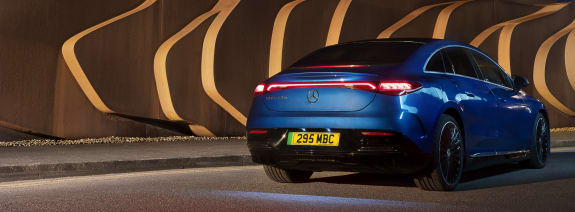Guide to Plug-in Hybrids (PHEV)
If you're not ready to go all-out electric, could a plug-in hybrid be for you? Our PHEV Guide explains the pros and cons, what to look out for, and more.

This page is devoted to the full fat, 100% Battery Electric Vehicle (BEV), offering zero-emission, low-cost motoring.
Ready for an electric adrenaline rush? Jump in to discover the secrets and many advantages of battery-powered driving.
Pure electric vehicles are great for the environment and offer stunning fuel savings. Read our 6-step guide, full of essential tips and advice:
Prefer video? Check out our "6 Reasons to Lease an Electric Car" explainer with Nicki Shields.
A fully electric car has no internal combustion engine. Instead of petrol or diesel, it runs on electricity.
How do you get electricity into the vehicle? You plug it into the mains, usually via a dedicated charging point either at home, work or in public.
The electricity stored in the vehicle’s battery then powers one or more electric motors that turn the wheels.
Battery Electric Vehicles are quiet to drive (no engine noise) and often enjoy fantastic acceleration, as there are no gears, and power from the battery gets applied instantly to the electric motor(s).
How far will an electric car go when the battery is fully charged? That depends on:
Most new EVs will travel between 130 and 300 miles on a single charge of the battery. Some are 400+ miles.
Read our Range Guide for further details on how both the ambient temperature and the way you drive have a direct bearing on the range you get in a BEV.
If you have off-street parking, get an EV charging point installed and charge your vehicle on a low-cost tariff. Each hour of charging typically adds 20-30 miles of range.
By charging at home, you can wake up each day to a ‘full tank’ of electricity – in other words, you start the day with maximum range.
When you are out and about, you will come across public charging points at supermarkets, carparks, hotels, restaurants, etc. Take your charging cable with you and top up if you need to.
For longer trips, stop at service stations and ‘rapid’ charge. Depending on which electric car you have and the charger itself, you can usually add between 60-150 miles’ range after 20 minutes of charging.
Charging at home is generally the cheapest. Rapid charging is the most expensive. Our Charging Guide has more details.
Battery Electric Vehicles allow you to make substantial fuel savings compared to a conventional vehicle, especially if you charge at home on an EV-friendly tariff.
Here are guideline monthly running costs for an Tesla Model Y SUV Long Range AWD 5dr Auto [2023], based on 8,000 miles a year, 24-month term, 9 months’ deposit, and assuming the car is charged overnight at an off-peak rate of 7p per kWh:
| Running Costs | Monthly |
| Lease payment | £386.45* |
| Petrol costs | £0 |
| Electricity costs | £11.67** |
| Road tax | £0 |
| Insurance (estimate) | £48.67 |
| Total per Month | £446.79 |
*Correct as of 5 December 2024. **Assuming official Model Y efficiency of 4 miles per kWh. Breakdown cover is included for at least the first year by the manufacturer.
Got questions?
Why not phone one of our friendly EV consultants on 0118 3048 688
or email us at enquiries@selectcarleasing.co.uk
All Battery Electric Vehicles are zero-emission. They don’t have exhaust pipes, and so cannot emit pollutants like CO2, NOx gases, particulate matter, and so on.
To go completely green, you also need to charge your vehicle with electricity from a renewable source, such as wind turbines and solar panels. Fortunately there are now a number of home electricity suppliers that offer renewable energy tariffs, such as OVO.
The other good news is that EV batteries last a long time – nowadays probably longer than the car itself – and have a good future. Most will have a second life in so-called ‘stationary storage’. Once the battery cells are then totally depleted, the battery will be recycled.
Of course if you lease an electric car for 2-4 years, you won’t have to worry about battery recycling and degradation, but it’s good to know the vehicle's battery will have a long life.
Once you start driving a BEV, your attention will turn quickly to your electricity bills.
If you charge your car at home, here are the main ways of keeping your EV energy costs down:
Now you've got a handle on the advantages of Battery Electric Vehicles, why not have a look at more of our EV Guides, together with our latest Electric & Hybrid lease deals below:
If you're not ready to go all-out electric, could a plug-in hybrid be for you? Our PHEV Guide explains the pros and cons, what to look out for, and more.
These are the hybrids you can't plug in, also known as 'self-charging'. Confused? You're not alone! Our quick guide tells it straight, explains charging, etc.
Don't know your kW from your kWh? This handy guide cuts through to the essentials, so you can lease the electric car that matches your needs.
Get the low-down on the most popular EVs in the UK. Read our ever-expanding review section, comparing and contrasting the latest models.
Thinking about electrifying your fleet? Attracted by ultra-low Benefit in Kind rates for EVs? Discover the wide range of financial incentives on offer.
Electric vehicles can save you a small fortune on fuel, but only if you charge at the right rate. Read our guide for electricity tariff tips, BEV v. PHEV...